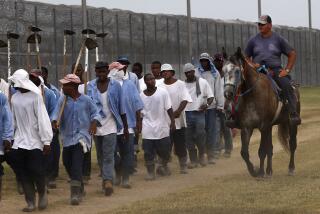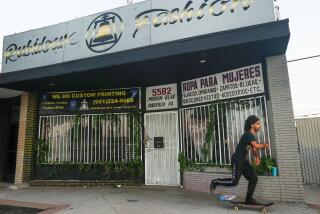Target of Farm Slavery Allegations Still an Enigma as Case Nears Close : Workers: Edwin Ives will plead guilty to immigration and labor violations. His defenders say he is a hard-working rancher and devout family man.
- Share via
As a Fairfax High School student in the 1950s, Eddie Isaac impressed classmates as a hustler by hawking flowers from street corners after school.
The son of a neighborhood shopkeeper, Isaac later worked the downtown Los Angeles flower markets, operated a florist shop in West Hollywood and eventually bought a small ranch near San Fernando.
But riches eluded him until 1979 when Isaac--who by then had changed his name to Edwin M. Ives--borrowed heavily to buy two Ventura County flower ranches.
He recruited Zapotec and Mixtec Indian laborers from the mountaintops of southern Mexico, allegedly smuggling them into the country and imprisoning them behind high gates and barbed-wire fences at a 50-acre compound near Camarillo.
As his workers toiled to harvest and dye ornamental leaves and flowers that Ives sold nationwide, prosecutors say, his profits reached $1 million a year. Along the way, they say, Ives turned into a modern-day slave master, cheating at least 300 poor and ignorant workers out of $3 million during the 1980s.
Ives’ assets totaled more than $5 million when a federal grand jury indicted him in 1990 in the most far-reaching slavery case ever filed by the U.S. government. Ives, 55, of Los Angeles, has agreed to plead guilty to seven immigration and labor violations and to pay about $1.5 million in back wages, the stiffest fine ever in a U.S. immigration case. His farming company also will admit to organized crime activity, the first racketeering conviction in a federal civil rights case, prosecutors say.
In exchange, the government will dismiss the extortion and slavery counts that brought the case international attention. Ives faces up to 18 years in prison, although his lawyers will ask for probation.
The plea bargain, to be made official when Ives changes his plea Monday, is a major turning point in a bizarre case whose central figure remains an enigma.
Even those who prosecuted him say the voracious ambition that marked his business activities does not appear to jibe with the ethical values that apparently guided his personal life.
Defense attorneys describe Ives as a hard-working rancher, a loner whose solitary nature made others suspicious, and a devout family man whose frequent pilgrimages to Israel reflect the depth of his Orthodox Jewish faith.
Ives has lived much of his life in the Fairfax area, graduating from high school, marrying and raising three children, and attending a nearby synagogue.
“His dad had a little neighborhood dry goods store,” said high school chum Larry Navis. “Eddie would sell flowers on a corner. He was a hard-working, good, honest guy.”
“He was a hustler, a street-smart kid,” dentist Burt Schnierow said of his former classmate. “We were all middle-class Jewish kids trying to work our way up, and a lot of us did.”
Rabbi Jack Simcha Cohen of Congregation Shaarei Tefila said before the plea bargain that he had no doubt that Ives, a friend for 14 years, was innocent.
“It’s inconceivable that this kind, decent man would have been involved in these outrageous, immoral acts,” Cohen said.
Ives--sometimes accompanied by his wife, Dolly, and children in court--has refused to be interviewed except for quick comments at hearings when he has said he has been treated unfairly by the government and the news media.
After Ives was indicted in May, 1990, the government pressed its prosecution with zeal, returning twice to the grand jury to add charges, determined to use the case to teach other abusive agricultural employers a lesson.
Although slavery charges are extremely rare, prosecutors said that some of the abuses uncovered on Ives’ ranch are found in farm communities around the state.
“The Ives case,” said Lee Pliscou, a California Rural Legal Assistance attorney who has filed a lawsuit for 29 former Ives employees, “represents the extreme. When people are hungry, even the worst job imaginable is better than no job.”
Ives’ attorneys insist that the rancher is hardly the modern-day Simon Legree seen by the government. They say he agreed to plead guilty to avoid ruinous legal costs and the prosecution of his wife. The deal also averted the possible seizure of his two houses and three ranches.
And they add that they could have produced 100 witnesses--about the same number as the prosecution--to testify that Ives was a fair employer to whom laborers returned year after year.
At least eight former ranch hands told Ives’ lawyers that the allegations were a lie, defense attorney Stephen Sadowsky said. Prosecutors acknowledge that selected employees, especially longtime ranch foremen, were apparently treated well.
But many former employees and business associates have joined prosecutors in concluding that Edwin Mitchell Ives is nobody’s victim, but rather a businessman of extreme shrewdness, ambition and cruelty.
“If Ed called to go to coffee, you knew he wanted something,” said Johnny Mellano, manager of the Los Angeles Flower Market. “Ed always had an edge to him. Everything he did he had a motive.”
The seed of how to become a big flower rancher apparently germinated at Ives’ small San Fernando farm in the late 1970s. There, Ives began to buy oval eucalyptus leaves from growers and treat them with glycerin so they would not become brittle in flower arrangements. He also began to grow the crop himself.
In 1979, Ives moved to become one of the nation’s largest growers and processors of eucalyptus leaves and wispy baby’s breath, both staples for florists nationwide.
He paid about $600,000 for 50 acres and a farmhouse in Ventura County, property records show. Two years later, he bought 92 acres nearby for about $900,000, a seller said. Then he bought a smaller ranch in Upland.
The federal prosecution of Ives involved allegations rumored in the tiny farming community of Somis, five miles north of Camarillo, almost since Ives bought an orange orchard there in 1979 and began to transform it into a walled compound.
For several years, dozens of workers would regularly emerge from the compound to cash checks, buy groceries and socialize. But that stopped in about 1983 or 1984, said a Somis merchant. Workers could be glimpsed inside the compound, but only a few would still frequent local businesses.
Ives was the subject of local and federal investigations throughout the 1980s. He was convicted of seven misdemeanor crimes involving building, safety and zoning violations after a major fire at the compound in 1987, court records show.
The Griffith-Ives Co., which Ives owns, was investigated by the U.S. Department of Labor four times from 1979 to 1985. Though they had no access to Ives’ compound, U.S. Border Patrol officers arrested 14 illegal immigrants outside it in 1984 and six more in 1989.
John Whitton, a Santa Paula competitor who described Ives as “extraordinarily sophisticated and shrewd,” said Ives lived frugally when at his ranch. The rancher would drive a beat-up station wagon, sleep on a couch in a room with no other furniture, and boil himself potatoes for lunch.
“I really think he’s a fairly decent man,” said Whitton, noting that in 20 years of doing business with Ives, he has never had problems. “I think he cared about his workers.”
But dozens of laborers have described Ives as a man who was regularly involved in illegal activities--personally forbidding workers to leave his ranch, telling them to buy at his company store and once paying a smuggler for services while workers watched.
Laborer Fernando Maldonado said Ives usually recruited workers from rural villages, instead of cities, because the villagers were so unsophisticated that they would work “like burros.”
Maldonado, 49, said he worked for Ives for three weeks in 1989 before escaping under a fence and through a deep ravine that borders the rancher’s compound on three sides.
“It was slave labor,” Maldonado said. “We realized we had entered the mouth of the wolf.”
More than a dozen workers, plaintiffs in a lawsuit against Ives, complained in interviews of a system of work and abuse that left them too tired to eat or flee.
The laborers said they were forbidden to leave the compound--where two locked gates guard the only entrance--until $435 in debts owed to a smuggler were deducted from their earnings.
Once the debts were paid, the workers said overseers threatened to turn them over to immigration agents if they left the compound.
Their typical workday began at 3:30 a.m. and ended at 8 p.m., they said. They allegedly were forbidden to drink water or use restrooms except at morning and noon breaks.
Workers were paid $100 every other week, after deductions, for nearly 200 hours of work, they said.
Food purchased from a tiny company store was overpriced, they said: $4.50 for a gallon of milk, $3.50 for a six-pack of soda and $1.50 for a pack of tortillas that costs 59 cents at supermarkets.
They claimed that the Griffith-Ives Co. deducted exorbitant amounts from paychecks for other necessities of life: $40 every two weeks to sleep in a filthy wooden barracks and to use unsanitary restrooms, $2 for cleaning, and additional charges for blankets, sheets, pillows, toilet paper and even for the tools they used on the job.
Defense attorneys say many of the allegations are ridiculous.
Sadowsky said there is strong evidence to show that former employees were free to leave the ranch to visit family and friends and shop for groceries, and that they bought designer clothing, cameras, stereos, radios and guitars. They took taxis to Oxnard and sometimes stayed in motels.
Why would Indian villagers return to Ives’ ranch year after year if they were abused and enslaved, Sadowsky asked.
Prosecutors acknowledge that some workers have returned to Ives’ ranch, but only because they saw it as their only job prospects in the United States. Most workers had never been outside the state of Oaxaca, said Assistant U.S. Atty. Carol L. Gillam, lead prosecutor in the case.
“The walls were not impermeable if they hadn’t feared what was on the outside--a world they had never seen,” Gillam said. “But they were told they would be arrested by immigration authorities if they left.”
Today, after a two-year slowdown, the Griffith-Ives Co. ranches are again productive, competitors said. Dolly Ives represented the company at a national buyers forum in Atlanta in January.
Many of Ives’ former workers live in caves or cardboard boxes on hillsides in northern San Diego County, prosecutors said. Some of Ives’ defenders argue that the laborers were better off at the Somis compound.
“But just ask those guys if they’re happier on the hillsides or at the ranch,” Gillam said. “They’ll say they’re a lot happier now. Don’t underestimate the importance of freedom to these guys.”
More to Read
Sign up for Essential California
The most important California stories and recommendations in your inbox every morning.
You may occasionally receive promotional content from the Los Angeles Times.










